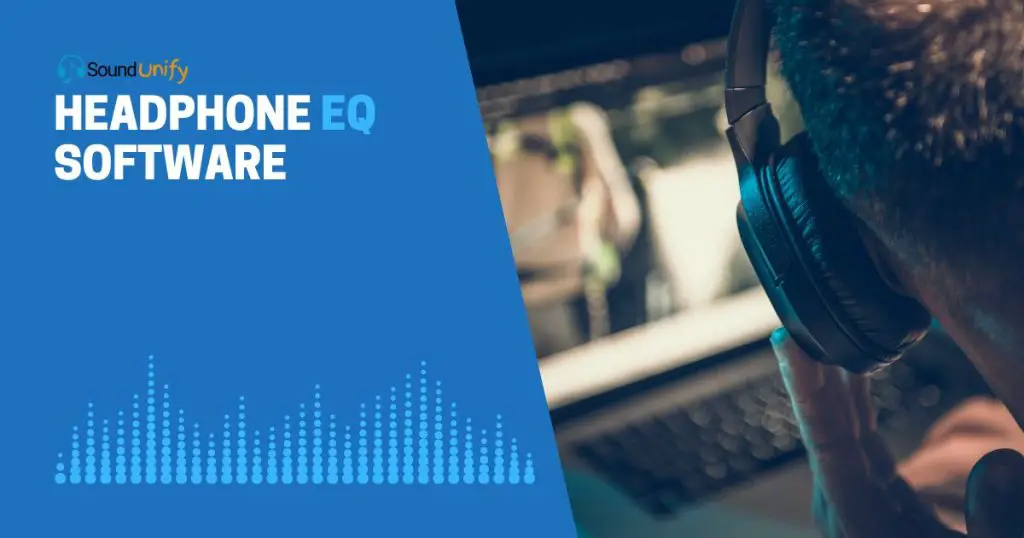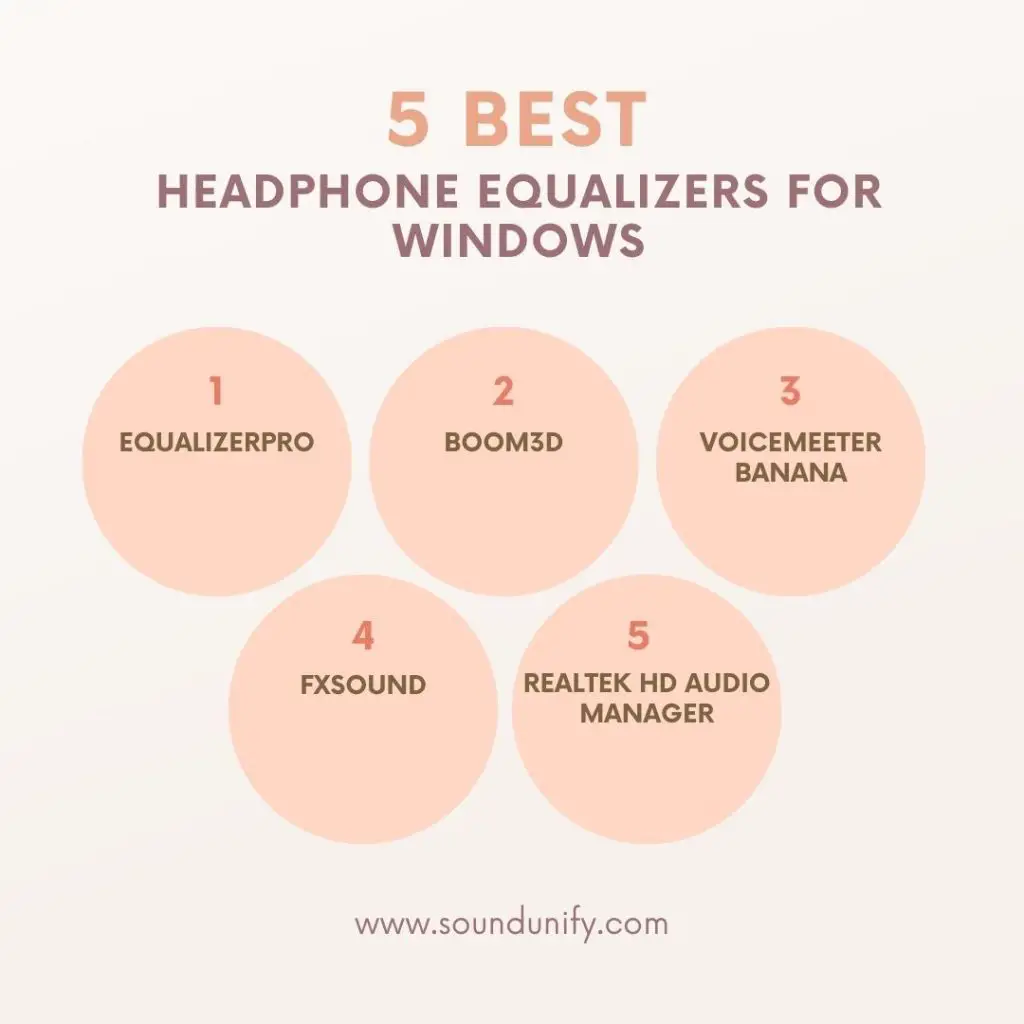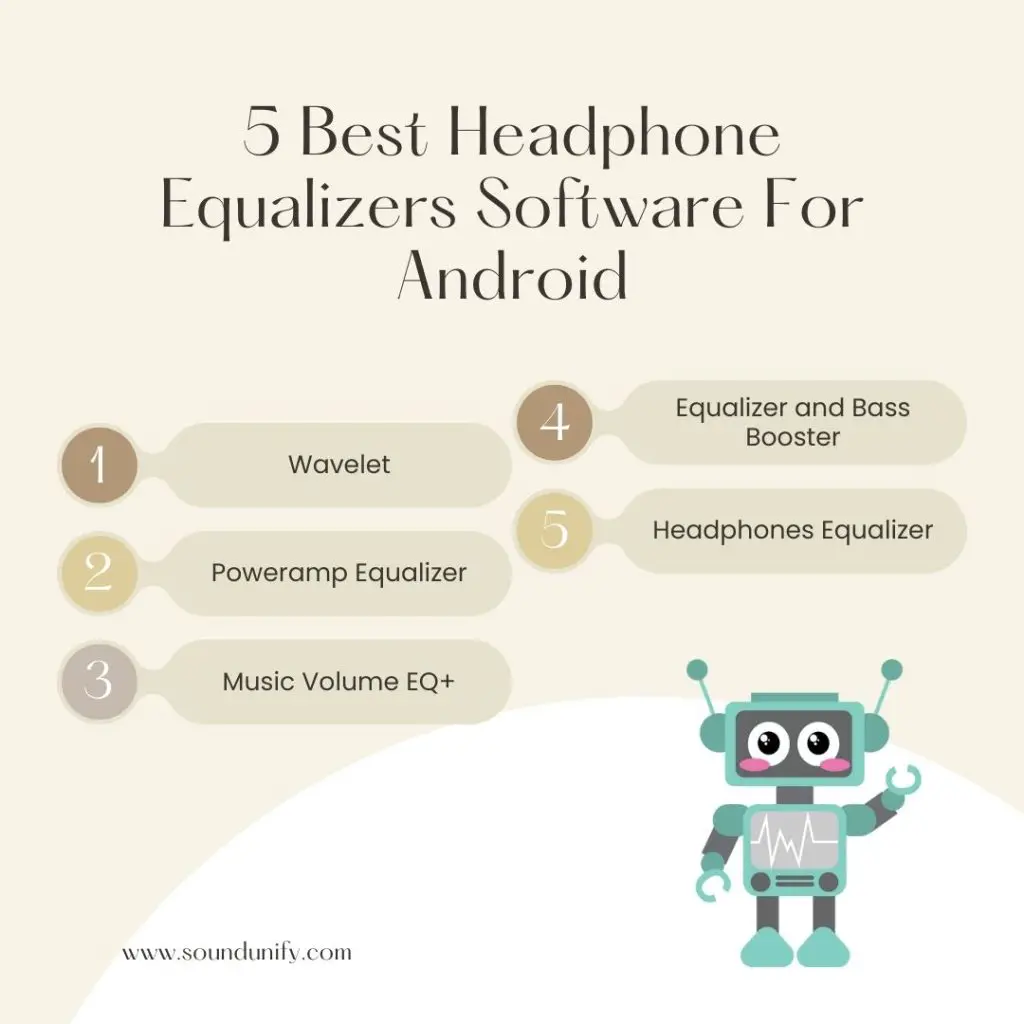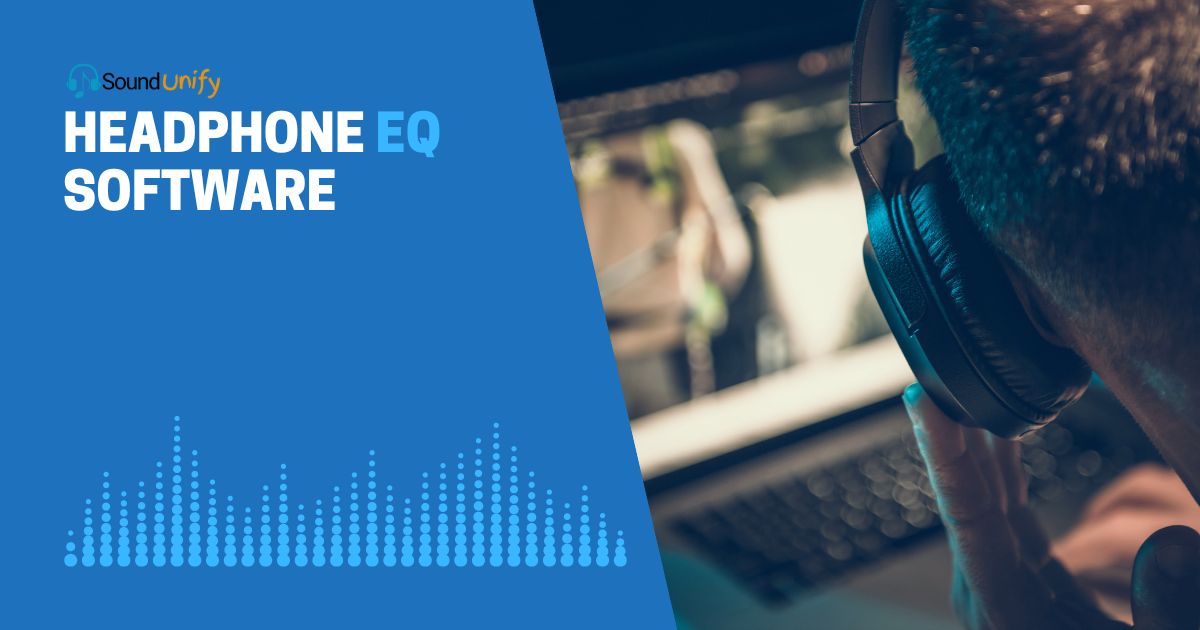Unleashing the power of headphone EQ software is like discovering a hidden treasure in your music. The magic wand transforms your audio experience into a symphony of pure delight.
Imagine You’re an explorer, and your headphones are a new world. But instead of a map, you have headphone EQ software.
It’s your guide to uncharted territories of sound, helping you uncover hidden nuances in your favorite songs that you never knew existed.
This software is more than just a tool; it’s a ticket to an audio adventure. It lets you tweak the frequency response of your headphones, allowing you to create a soundscape that’s uniquely yours.
And it’s not just about making your music sound better. It’s about solving those pesky audio problems that can disrupt your listening experience, like drowned-out vocals or intrusive background noise.
So, join me on this exciting journey into headphone EQ software. Together, we’ll turn your audio experience into a thrilling expedition of discovery and enjoyment. Your music is waiting!
What is Headphone EQ Software?

Headphone EQ software is like a secret key to unlocking the full potential of your audio experience. But what exactly is it? Let’s break it down.
Headphone EQ (Equalizer) software is a digital tool that manipulates the frequency response of your audio device. Now, you might be wondering, “What’s frequency response?” In simple terms, it’s the range of bass, mids, and treble that your headphones can produce.
The EQ software adjusts the balance between these frequency components in an audio signal. Imagine having a personal sound engineer tweak the knobs on an equalizer to get the perfect sound. That’s what EQ software does for you.
Now, let’s talk about the health aspects. Listening to music at high volumes can damage your hearing over time. EQ software can help mitigate this risk. You can fix your ears by decreasing the intense sounds and making them softer. This is better for your hearing.
From my experience, using EQ software has improved my audio experience. I can change the sound on my device to suit my taste. This is especially helpful when changing between different media types, like music, podcasts, or movies.
Here’s a simple comparison table to illustrate the difference between using headphones with and without EQ software:
| Aspect | Without EQ Software | With EQ Software |
|---|---|---|
| Sound Quality | Fixed, depends on the headphones’ built-in tuning | Customizable, can be adjusted to personal preference |
| Volume Levels | I may need to be high to hear all details | It can be lower due to balanced frequencies, safer for ears |
| Versatility | One-size-fits-all sound profile | Can adjust sound profile based on the media type |
5 Best Headphone Equalizers For Windows

The right EQ software can transform your audio experience. Here are my top five picks for the best headphone Equalizers software for Windows, along with their pros and cons:
1. EqualizerPro
EqualizerPro is a comprehensive EQ software that offers a 10-band equalizer with over 20 presets. This feature allows you to adjust the sound across various frequencies. Whether you want to boost the bass or enhance the treble, EqualizerPro has got you covered.
Additionally, it allows for custom profiles. So you can create your sound signature. This is particularly useful if you switch between different types of audio content, such as music, podcasts, or movies.
But, it’s worth noting that EqualizerPro is not free, which might be a downside for some users.
| Pros | Cons |
|---|---|
| 10-band equalizer | Not free |
| Over 20 presets | |
| Allows for custom profiles |
2. Boom3D
Boom3D stands out for its 3D surround sound feature, which can make your music and movies sound more immersive. This can give you the feeling of being in a live concert or movie theatre.
Boom3D also has a sleek, user-friendly interface, making it easy to adjust the settings even if you’re not an audio expert.
However, it’s premium software and some users have reported compatibility issues with specific devices.
| Pros | Cons |
|---|---|
| 3D surround sound | Premium software |
| User-friendly interface | Possible compatibility issues |
3. Voicemeeter Banana
Voicemeeter Banana is more than just an equalizer; it’s a virtual audio mixer allowing complex adjustments. You can control the EQ and other audio settings, such as volume and panning.
It’s great for those who want complete control over their audio. However, its complexity can be overwhelming for beginners. It might take some time to learn how to use all the features.
| Pros | Cons |
|---|---|
| Full control over audio | Complexity can be overwhelming for beginners |
| Advanced features |
4. FXSound
FXSound focuses on enhancing the sound quality of your digital audio. It uses advanced DSP (Digital Signal Processing) to make your music sound clearer, fuller, and louder.
It’s easy to use and offers a range of presets, so you can quickly find a sound profile that suits your taste. However, the free version has limited features, and you’ll need to upgrade to access the full functionality.
| Pros | Cons |
|---|---|
| Enhances sound quality | The free version has limited features |
| Easy to use and offers a range of presets | Need to upgrade for full functionality |
5. Realtek HD Audio Manager
Realtek HD Audio Manager is the default software for many Windows PCs, making it a convenient option.
It offers basic audio adjustments, such as volume control and balance. This can be useful if you want to tweak your sound.
However, it lacks the advanced features of dedicated EQ software, such as multiple bands and custom profiles.
| Pros | Cons |
|---|---|
| Default software for many Windows PCs | Lacks advanced features |
| Offers basic audio adjustments |
5 Best Headphone Equalizers Software For Android

Here are five popular headphone equalizer software options for Android:
1. Wavelet
Wavelet is an advanced EQ app that’s specifically designed for headphones. It offers over 2300 precalculated optimizations for various headphone models, which can significantly improve sound quality.
Select your headphone model from the list, and the app will automatically apply the best EQ settings. It’s like having a personal sound engineer who knows your headphones inside out.
In addition to this, Wavelet provides a 9-band graphic equalizer for custom adjustments. This allows you to fine-tune the sound to your personal preference. However, the wide range of features might be overwhelming for beginners.
| Pros | Cons |
|---|---|
| Over 2300 precalculated optimizations | It may be complex for beginners |
| 9-band graphic equalizer |
2. Poweramp Equalizer
Poweramp Equalizer is a powerful EQ app that offers a 10-band optimized graphical equalizer for all supported formats, presets, custom presets, and per-song/per-list/per-output preset assignments.
You can have different EQ settings for each song, playlist, or output device. It also provides advanced tuning options, including .eq preset files support and separate powerful Bass and Treble adjustments.
This gives you a high level of control over your sound. However, some features require purchase.
| Pros | Cons |
|---|---|
| 10-band optimized graphical equalizer | Some features require the purchase |
| Advanced tuning options |
3. Music Volume EQ+
Music Volume EQ+ is a user-friendly EQ app with a five-band equalizer, virtualizer effects, and bass boost. The virtualizer effect can make your music sound more immersive like you’re in a live concert.
It also provides nine equalizer presets and allows for custom settings. This means you can quickly switch between different sound profiles based on your mood or the type of audio.
The app features a home screen widget, a live spectrum analyzer, and edge lighting. However, the equalizer only has five bands, which might be limiting for some users.
| Pros | Cons |
|---|---|
| User-friendly | Limited bands in the equalizer |
| Home screen widget and live spectrum analyzer |
4. Equalizer and Bass Booster
Equalizer and Bass Booster is a simple yet effective EQ app with a five-band equalizer and bass boost effect. The bass boost can make your music sound more prosperous and more powerful.
It also includes a virtualizer effect and 16 colourful themes, making the app more enjoyable. The app provides ten presets based on different music genres, so you can quickly adjust the sound to match the music.
However, the equalizer only has five bands, which might be limiting for some users.
| Pros | Cons |
|---|---|
| Simple and effective | Limited bands in the equalizer |
| 16 colorful themes |
5. Headphones Equalizer
Headphones Equalizer is an EQ app designed specifically for headphones. It allows you to test your headphones and then creates a personalized equalization based on the results.
This can help you get the best sound quality from your headphones. The app offers a five-band equalizer, bass boost, and virtualizer. It also provides automatic preset switching based on the music genre.
So the sound can automatically adjust to match the music. However, some features require purchase.
| Pros | Cons |
|---|---|
| Designed specifically for headphones | Some features require the purchase |
| Automatic preset switching |
5 Best Headphone Equalizers Software For iOS

Here are five popular headphone equalizer software options for iOS:
1. Equalizer+ HD music player
Equalizer+ HD music player is an all-in-one music player with tons of features under its hood. For starters, it houses a 7-band bass booster, ten equalizers presets, custom presets, AirPlay compatibility, excellent visualizers, a queue system, and a sleep timer.
It brings all your music from iTunes, Google Drive, or Dropbox to one platform. And thanks to the handy offline mode, you can play it without the internet or WiFi.
Further, it can also auto-optimize the sound quality according to the headphones being used.
| Pros | Cons |
|---|---|
| All-in-one music player | It may be complex for beginners |
| Auto-optimization of sound quality | In-app purchases |
2. Boom: Bass Booster & Equalizer
Boom is an app that can add the magic of 3D surround sound to the whole experience. You also get a bass booster, 16-band equalizer, 29 handcrafted EQ presets, and more.
Understanding the latest trend in the business, boom offers seamless support to music streaming services like Spotify & TIDAL.
You can also stream over 40k worldwide radio stations and podcasts while fine-tuning their output as per preference.
| Pros | Cons |
|---|---|
| 3D surround sound | Some features require the purchase |
| Support for music streaming services |
3. Flacbox: FLAC Player Equalizer
Flacbox is a powerful music player and downloader with a built-in audio equalizer and bass booster. Whether MP3 or WMA, iCloud or HiDrive, Flacbox supports numerous audio formats and offline or online storage services.
With professional-level audio equalization settings, you can make any music truly yours. For instance, if the audio is not loud enough, you can quickly change the preamplifier gain.
Other notable features include auto-music sync, playback speed control, audio bookmarks, and background mode.
| Pros | Cons |
|---|---|
| Supports numerous audio formats | Some features require the purchase |
| Professional-level audio equalization settings |
4. Equalizer Pro +
Equalizer Pro + features a highly optimized equalizing algorithm that uses much less battery than similar apps. You can enjoy high-quality equalization without any distortion.
It’s great for an extra sound boost on your iPhone or fine-tuning sound in-car audio. It helps to fine-tune sounds so that whatever you’re listening to sounds fantastic, whether metal, country, rap, or something else.
| Pros | Cons |
|---|---|
| Highly optimized equalizing algorithm | Paid app |
| High-quality equalization without distortion |
5. jetAudio – MP3 Music Player
jetAudio is known for its easy-to-use interface and broad audio file format compatibility. Along with the 16 equalizer presets, it also boasts a 10/20 band graphic equalizer for those who love customizing their sound experience.
You can also save the equalizer customizations and apply them to other similar playlists.
jetAudio also features advanced playback functions such as speed control, crossfading, ReplayGain, pitch correction, and AGC.
| Pros | Cons |
|---|---|
| Easy-to-use interface | Some features require the purchase |
| Broad audio file formats compatibility |
How Does Headphone EQ Software Work?
Headphone EQ software, or equalizers, adjust the balance between frequency components within an electronic signal.
They allow you to fine-tune your device’s audio output to match your preference or compensate for the acoustics of your environment.
Here’s a more details at how they work:
1. Understanding Frequencies
Sound is made up of various frequencies. Low frequencies correspond to bass sounds, high frequencies correspond to treble sounds, and mid-range frequencies correspond to most audible sounds. You hear a mix of these frequencies when listening to music or audio.
2. Adjusting Frequencies
An equalizer allows you to adjust these frequencies. It does this by boosting or reducing specific frequency bands. For example, if you feel a song’s bass (low frequencies) is too weak, you can use an equalizer to boost the bass.
3. Bands and Sliders
Equalizers typically have multiple bands or sliders, each corresponding to a specific range of frequencies. For example, a 5-band equalizer might have bands for bass (low frequencies), low midrange, midrange, upper midrange, and treble (high frequencies). By adjusting these bands, you can shape the sound output.
4. Presets
Many equalizers come with presets, pre-configured settings designed for specific types of audio. For example, a “Rock” preset might boost the bass and treble frequencies to give a more ‘punchy’ sound.
5. Customization
Advanced equalizers allow for a high degree of customization. You can create your own presets based on your personal preferences. This is particularly useful for audiophiles who want to fine-tune their audio experience.
What Is the Best Equalizer Setting for Headphones?
The best EQ setting for headphones is highly subjective. It depends on various factors, such as the type of music you’re listening to, the quality of your headphones, and your personal preferences.
However, here are some general guidelines that can help you find the proper EQ settings for your needs:
1. Frequency Spectrum
Understanding the frequency spectrum is crucial when adjusting your EQ settings. Sound comprises various frequencies, each contributing to the overall audio experience.
Here’s a more detailed breakdown:
- Sub-bass (16 – 60 Hz): This is the lowest range of frequencies. It’s where you’ll find the deep, rumbling sounds you can often feel as much as you hear. In music, this range is typically occupied by the lowest notes of a bass guitar or a kick drum.
- Bass (60 – 250 Hz): This range is still on the low end of the spectrum, but it’s where the bulk of the bass resides. The punchy, powerful sounds give the music its rhythm and drive.
- Lower Midrange (250 – 500 Hz): This is where the lower notes of most musical instruments lie. It’s also where male vocals typically sit. Boosting these frequencies can warm the music, but too much can make it sound muddy.
- Midrange (500 – 2 kHz): This is the heart of the audible spectrum. Most musical instruments have a significant presence in this range, and it’s also where female vocals typically sit. It’s often the focus of many EQ adjustments.
- Higher Midrange (2 – 4 kHz): This range is crucial for clarity and presence in the music. The higher notes of musical instruments and the sibilance (the ‘s’ and ‘t’ sounds) in vocals reside.
- Presence (4 – 6 kHz): This range is responsible for the clarity and definition of voices and instruments. Boosting these frequencies can make the music seem closer to the listener.
- Brilliance (6 – 20 kHz): This is the highest range of frequencies. It’s where the sparkle and airiness of music reside. These frequencies add a sense of realism and space to the music.
Understanding these frequency ranges can help you make more informed decisions when adjusting your EQ settings. Remember, the goal is to enhance the audio, not overpower it.
2. Use Presets
Many EQ software comes with presets, pre-configured settings designed for specific types of audio. These presets can be a great starting point for finding your ideal EQ settings. For instance:
| Preset | Description |
|---|---|
| Rock | Boosts the bass and treble frequencies for a more ‘punchy’ sound |
| Pop | Enhances the mid-range frequencies to bring out vocals |
| Jazz | It provides a balanced sound that’s ideal for the complex arrangements in jazz music |
| Classical | Offers a flat EQ for a natural and uncoloured sound |
3. Adjust Settings Based on Activity
Your ideal EQ settings might change based on what you’re doing. Here are a few examples:
- Watching a Movie: You might want to boost the low frequencies to enhance the sound effects and create a more immersive experience.
- Listening to a Podcast: Boosting the mid-range frequencies can make the vocals clearer and easier to understand.
- Listening to Music: Your EQ settings will largely depend on the genre of music. For instance, you might want to boost the bass for hip-hop tracks or enhance the mid-range for rock songs.
4. Make Small Adjustments
When it comes to adjusting your EQ settings, less is often more. Making drastic changes can lead to a distorted or unnatural sound. Instead, try making minor, incremental adjustments.
For example, if you’re boosting the bass, try increasing it by just a few decibels at a time. Listen carefully to the changes and adjust accordingly.
This method lets you fine-tune the sound to your liking without overwhelming your ears or speakers.
5. Cut the Bass Before 150 to 200 Hz
If your audio sounds too muddy or lacks clarity, it might be due to an excess of low frequencies. A common technique to address this is to cut the bass frequencies before 150 to 200 Hz.
This range often contains the “mud” that can cloud your mix. Reducing these frequencies can help clear up the sound and bring more focus to the mid and high frequencies.
However, be careful not to cut too much, as it can make your audio sound thin or weak. It’s all about finding the right balance.
6. Boost Frequencies Around 400 Hz
The frequencies around 400 Hz are often associated with warmth and fullness in a mix. If your audio sounds thin or lacks depth, try boosting these frequencies.
This can help to fill out the sound and make vocals or mid-range instruments stand out more. However, just like cutting the bass, making subtle adjustments is essential.
Boosting too much can make your audio sound boxy or muffled. As always, use your ears as your guide and adjust to taste.
FAQs
Is there any headphone eq software specifically designed for Windows 10?
Yes, several headphone eq software options are available for Windows 10. Some famous examples include Equalizer APO, Equalizer for Windows 10, and Equalizer Pro.
Can the equalization settings be customized using headphone eq software?
Yes, headphone eq software provides customization options for equalization settings. You can adjust frequency, gain, and bandwidth parameters to achieve the desired sound signature.
How does headphone eq software affect CPU usage?
The CPU usage of headphone eq software can vary depending on the complexity of the equalization settings and the efficiency of the software itself. In general, CPU usage is minimal and should not significantly impact the performance of your system.
Can headphone eq software be used with any headphones?
Yes, headphone eq software can be used with any headphones as long as they are connected to your computer or audio device. It allows you to customize the audio output regardless of the brand or model of your headphones.
Can headphone eq software enhance the overall audio quality?
Yes, headphone eq software can enhance the overall audio quality by allowing you to adjust the sound according to your preference. It can help compensate for any deficiencies in the original audio source and improve the listening experience.
Final Thoughts
I’ve grown to appreciate the power of headphone EQ software. It’s a game-changer, transforming how we experience music and sound.
From enhancing bass to refining treble, it’s like having a personal sound engineer at your fingertips. Whether you’re a casual listener or an audiophile, there’s EQ software out there for you.
So, explore, and let your ears be the judge. After all, the best sound is the one that resonates with you. Happy listening!
James Dimento is a Chief-in-Editor of SoundUnify. He is a headphone enthusiast and creative writer passionate about audio technology. He has three years of experience writing about headphones and sound quality and is responsible for creating reviews and taking care of all administration.
